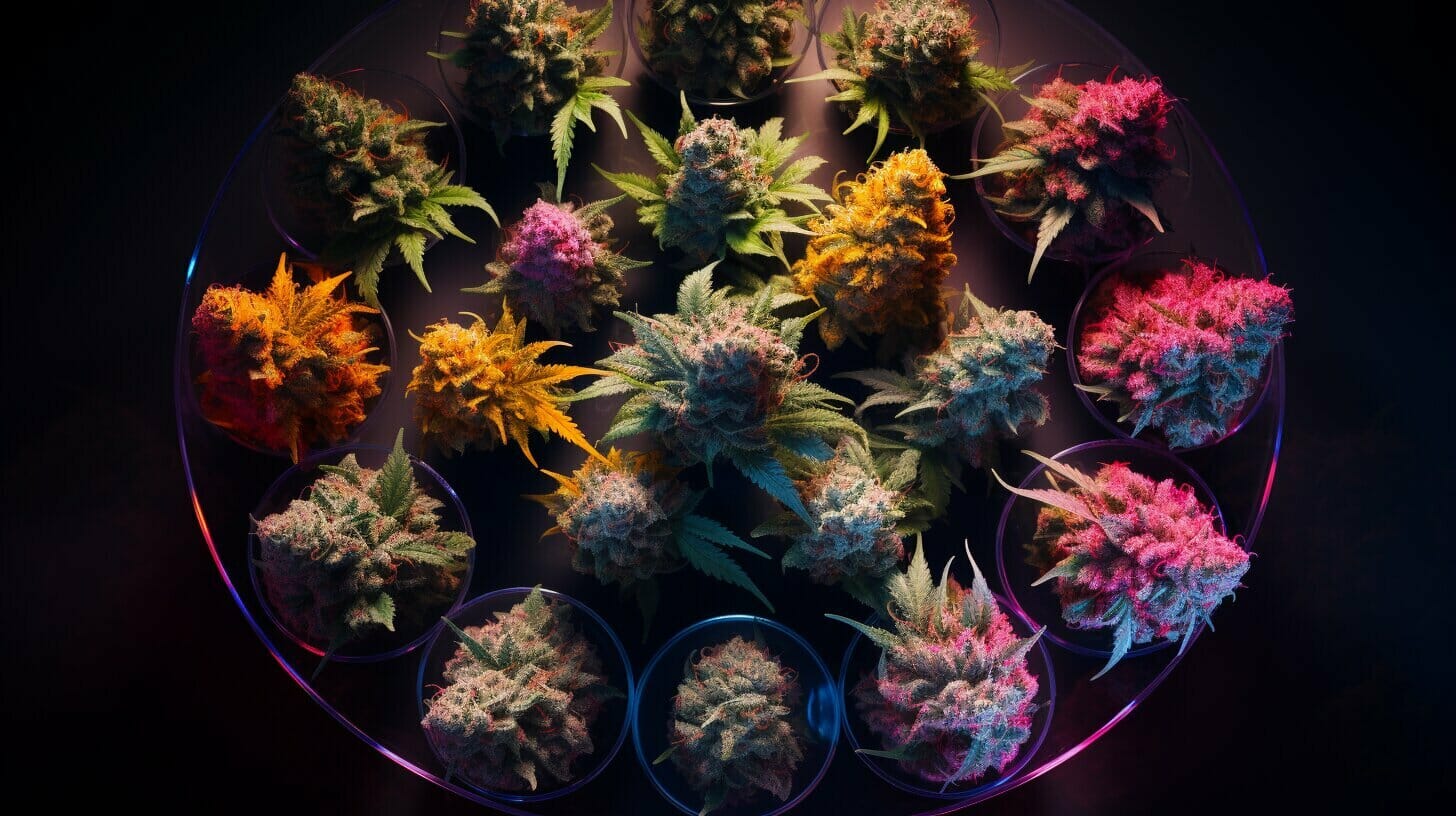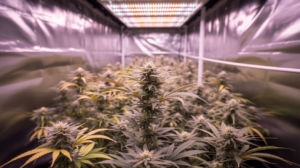Top Cannabis Breeding Methods: Expert Insights & Techniques

Effective cannabis breeding requires careful consideration of a range of factors, including genetic traits, potency, and disease resistance. By utilizing the latest breeding techniques and best practices, cultivators can optimize their yields, create unique and desirable strains, and stay ahead in a rapidly evolving industry.
In this article, we will provide expert insights and techniques on top cannabis breeding methods, including traditional and advanced techniques, creating new strains through crossbreeding, and employing innovative tools and technologies to enhance breeding efficiency. We will explore the importance of selecting the right parent plants for breeding, the benefits of using feminized seeds, and the use of tissue culture and molecular breeding techniques to maximize success.
Key Takeaways:
- Cannabis breeding requires careful consideration of genetic traits, potency, and disease resistance.
- Using the latest cannabis breeding methods and best practices can optimize yields and create unique and desirable strains.
- Selecting the right parent plants for breeding, using feminized seeds, and employing tissue culture and molecular breeding techniques can all contribute to success.
Understanding Cannabis Breeding Methods
Cannabis breeding is an intricate science that involves the careful selection and manipulation of genetic traits to create new and improved strains. There are various breeding techniques used in the cannabis industry, ranging from traditional methods such as selective breeding to advanced approaches like tissue culture and molecular breeding.
Selective breeding, also known as phenotypic selection, involves choosing plants with desirable traits and breeding them together to create offspring with those same characteristics. This method has been used for centuries and is still widely used today. However, it can be a time-consuming process, as it takes several generations to stabilize traits and achieve consistency in offspring.
Another traditional breeding technique is crossbreeding, which involves breeding two different strains to create a new hybrid strain with desirable traits from both parents. This method can be used to improve potency, yield, and disease resistance, among other traits.
Advanced Cannabis Breeding Methods
With advancements in technology, new cannabis breeding methods have emerged in recent years. One such technique is tissue culture, which involves growing plant cells in a nutrient-rich medium to produce clones of a desired plant. This technique is widely used in the production of high-yielding and disease-resistant crops, including cannabis.
Molecular breeding is another advanced approach that involves using DNA analysis to identify desired traits more efficiently. This method allows breeders to select plants with specific genetic markers and breed them together to create offspring with those same markers. This can save time and resources and lead to more precise breeding outcomes.
Other innovative tools and technologies, such as automation and data analysis, can also be used to enhance breeding efficiency and yield high-quality strains.
Selecting Parent Plants for Breeding
Successful cannabis breeding strategies rely heavily on selecting the right parent plants for the desired results. The following are some key factors to consider:
| Factor | Consideration |
|---|---|
| Genetic traits | Choose plants with desirable traits such as yield, potency, and flavor. |
| Potency | Choose plants with high levels of cannabinoids and terpenes. |
| Disease resistance | Choose plants that are resistant to common diseases such as powdery mildew and spider mites. |
Expert tips for cannabis breeding include selecting plants that are healthy, strong, and have a good root structure. It is also important to consider the compatibility of parent plants, as certain combinations may produce unfavorable results. To increase the chances of success, it is recommended to use a breeding journal to document the characteristics of each breeding pair.

Creating New Cannabis Strains Through Crossbreeding
Crossbreeding is a popular method used by cannabis breeders to develop unique and potent strains. This process involves combining the genetics of two or more cannabis strains to create a new hybrid variety with desirable traits.
There are different approaches to crossbreeding, including:
- Open Pollination: allowing plants to pollinate freely, resulting in a diverse population of plants with unique traits.
- Selective Breeding: intentionally selecting plants with desirable traits to breed and eliminate plants with unfavorable traits.
- Backcrossing: crossing a hybrid plant with a parent plant to reinforce specific genetic traits.
The goal of crossbreeding is to produce a new strain that exhibits the best attributes of its parent plants while minimizing undesirable traits. Breeders often prioritize characteristics such as potency, flavor, aroma, yield, and disease resistance when selecting parent plants.
Innovative Approaches to Crossbreeding
Cannabis breeders are constantly seeking new and innovative methods to create unique and potent strains. Some of the cutting-edge approaches to crossbreeding include:
- Chemical Induction of Mutations: exposing plants to mutagens such as radiation or chemicals to create variant strains with unique traits.
- In Vitro Fertilization: fertilizing eggs in a laboratory to create new hybrid strains without the need for physical pollination.
- Genetic Engineering: using gene editing techniques to modify the DNA of cannabis plants, potentially allowing breeders to create new strains with precise genetic characteristics.
While these methods are still relatively new and controversial, they show promise in creating unique and potent cannabis strains.
Utilizing Feminized Seeds for Breeding
Feminized seeds have become an increasingly popular choice among cannabis breeders due to their ability to produce only female plants, eliminating the need for sexing and saving time and resources.
Using feminized seeds can also improve breeding efficiency by ensuring genetic consistency and stability. By eliminating the risk of male plants pollinating female plants, breeders can focus on selecting and combining desirable traits from the same genetic pool, producing offspring with predictable characteristics.
To effectively utilize feminized seeds in breeding, it is important to carefully select the parent plants based on their genetic qualities and desired traits. Some breeders may choose to use cultivars that have already been stabilized through generations of inbreeding, while others may prefer to cross two different strains to create a hybrid with unique characteristics.
When breeding with feminized seeds, it is also important to pay close attention to environmental factors such as light cycles, humidity, and temperature to ensure optimal growing conditions. By providing the right conditions, breeders can maximize the potential of their feminized seeds and produce top-quality strains.
Employing Tissue Culture for Cannabis Breeding
In recent years, tissue culture has emerged as an advanced technique for cannabis breeding. This method involves growing cannabis cells in a laboratory setting, offering several advantages over traditional breeding approaches. By employing tissue culture, breeders can produce an exact replica of the parent plant, ensuring genetic stability and consistency in their breeding programs.
One of the key benefits of using tissue culture is that it enables breeders to clone elite cannabis plants on a large scale. This process involves taking a small sample of tissue from the parent plant and placing it in a nutrient-rich medium that contains hormones to stimulate growth. The cells will then divide and develop into a genetically identical clone of the parent plant.
| Advantages of Tissue Culture for Cannabis Breeding | Disadvantages of Tissue Culture for Cannabis Breeding |
|---|---|
| Ability to clone elite parent plants | Requires specialized equipment and expertise |
| Produces genetically identical plants | Higher risk of contamination and infection |
| Increases breeding efficiency and consistency | More expensive than traditional breeding methods |
While tissue culture can be an effective tool for cannabis breeding, it does have some drawbacks. The process requires specialized equipment and expertise, making it more expensive than traditional breeding methods. There is also a higher risk of contamination and infection, as the plants are grown in a sterile laboratory environment.
Despite these limitations, tissue culture is gaining popularity in the cannabis industry for its ability to produce genetically identical plants and increase breeding efficiency and consistency. By employing this cutting-edge technique, breeders can ensure the production of high-quality cannabis strains with desirable traits.
Implementing Molecular Breeding Techniques
In recent years, molecular breeding techniques have emerged as a game-changing tool in cannabis cultivation. By analyzing the DNA of cannabis plants, breeders can identify and select desirable genetic traits more efficiently, leading to improved breeding outcomes.
DNA Analysis: To apply molecular breeding techniques, breeders begin by analyzing the DNA of parent plants and offspring. This data is then used to identify specific genetic markers that are associated with desirable traits such as potency, disease resistance, and yield. By targeting these markers, breeders can create new strains with optimal genetic profiles.
Marker-Assisted Selection: Along with DNA analysis, another technique used in molecular breeding is marker-assisted selection. This involves the use of genetic markers to identify and select plants with desirable traits during the breeding process. Breeders can use this method to rapidly evaluate large numbers of plants and select the best candidates for crossbreeding.
While molecular breeding techniques are still relatively new to the cannabis industry, they have already been proven effective in enhancing breeding efficiency and producing superior strains. By leveraging the power of science and technology, breeders can unlock the full potential of cannabis cultivation and bring new and innovative strains to the market.
Enhancing Breeding Efficiency with Technology
The cannabis breeding process can be lengthy and labor-intensive, requiring significant time and resources to achieve desirable results. However, advancements in technology have made it possible for growers to enhance the breeding process, increasing efficiency and improving outcomes.
One way to improve efficiency is through automation. Automated systems can handle tasks such as watering, fertilizing, and monitoring environmental conditions, allowing growers to focus on other aspects of breeding.
| Technology | Description |
|---|---|
| Data Analysis | Software programs can be used to analyze data and identify breeding trends. This allows growers to make informed decisions about which strains to breed and how to achieve desired traits. |
| Drones | Drones can be used to monitor plants and collect data without the need for manual labor. This not only enhances efficiency but also reduces the risk of human error. |
| Robotics | Robotic systems can be used to handle tasks such as cloning and trimming, reducing the need for manual labor. This can save time and improve accuracy. |
Data analysis is another technology that can be used to enhance breeding efficiency. Software programs can analyze data and identify breeding trends, allowing growers to make informed decisions about which strains to breed and how to achieve desired traits.
Finally, molecular breeding techniques such as DNA analysis and marker-assisted selection can also be used to improve breeding outcomes. These techniques allow growers to identify desirable traits more efficiently, reducing the need for trial and error.
Best Practices for Cannabis Breeding
Successful cannabis breeding requires a combination of science, art, and expertise. To maximize your breeding efforts and yield top-quality strains, consider the following best practices:
1. Maintain Genetic Diversity
It is important to maintain genetic diversity in your breeding program to prevent inbreeding depression and optimize the potential for genetic variation. This can be accomplished by using a diverse population of parent plants and regularly introducing new strains into your breeding program.
2. Manage Breeding Populations
Managing breeding populations is essential for maintaining genetic stability and preventing the loss of desirable traits. Breeding populations should be managed carefully to ensure that genetic diversity is maintained, and new strains are regularly introduced.
3. Ensure Proper Environmental Conditions
The growth environment of your parent plants can significantly impact breeding outcomes. It’s essential to ensure that your plants are grown under the right conditions, including proper lighting, nutrient levels, and temperature, to optimize breeding results.
4. Use Advanced Breeding Techniques
Advances in breeding techniques, such as tissue culture and molecular breeding, have revolutionized cannabis breeding. Consider incorporating these techniques into your breeding program to achieve better results.
5. Test and Evaluate Breeding Results
Thoroughly testing and evaluating the results of your breeding program can help you identify desirable traits, improve breeding outcomes, and produce top-quality strains. Consider testing for traits such as potency, yield, disease resistance, and flavor.
- Test for potency using high-performance liquid chromatography (HPLC) to accurately quantify THC and CBD levels.
- Evaluate yield by measuring the weight of dried buds produced per plant.
- Test for disease resistance by exposing plants to common pathogens and evaluating their response.
- Evaluate flavor by conducting sensory evaluations to identify unique and desirable taste profiles.
By adhering to these best practices and utilizing advanced breeding techniques, you can optimize your breeding program and produce top-quality cannabis strains.
Testing and Evaluating Breeding Results
Once the breeding process is complete, it’s essential to evaluate the results to ensure the production of high-quality cannabis strains. Here are some expert tips for testing and evaluating breeding outcomes:
- Phenotypic evaluation: This involves analyzing the physical characteristics of the plant, such as its size, shape, and color, to determine its suitability for cultivation.
- Potency testing: Evaluating the potency of a strain is crucial to ensure its effectiveness for medical or recreational use. This can be done through chemical analysis or by testing the strain’s effects on users.
- Genetic analysis: Utilizing DNA analysis can help identify desirable traits and verify genetic stability and consistency in breeding programs.
- Field testing: Testing the strain in real-world conditions can help breeders assess its adaptability and performance under various environmental factors and stressors.
By utilizing these testing and evaluation methods, breeders can ensure the production of top-quality cannabis strains and optimize breeding efforts.
Top Cannabis Breeding Methods: Conclusion
Breeding cannabis is both an art and a science that requires careful consideration of various factors and techniques. To achieve optimal cultivation and yield high-quality strains, growers must use the top cannabis breeding methods available.
From understanding different breeding techniques to selecting the right parent plants, utilizing feminized seeds, and employing advanced technologies including tissue culture and molecular breeding, there are various approaches that growers can take to enhance their breeding efforts.
Importance of Best Practices for Cannabis Breeding
Following best practices for cannabis breeding is crucial for success. Maintaining genetic diversity, managing breeding populations, ensuring proper environmental conditions, and testing and evaluating breeding results are all important steps that growers should take to achieve their desired outcomes.
By implementing these techniques and strategies, growers can produce unique and potent cannabis strains that meet the demands of both recreational and medical users.
As the cannabis industry continues to evolve and grow, staying up-to-date with the latest breeding methods and technologies will become increasingly important for success.
FAQ
Q: What are the top cannabis breeding methods?
A: The top cannabis breeding methods include traditional techniques such as crossbreeding, as well as advanced approaches like employing tissue culture and implementing molecular breeding techniques.
Q: Why is it important to use the best practices for breeding cannabis?
A: Using the best practices for breeding cannabis is crucial to optimize cultivation and achieve high-quality strains. It ensures genetic stability, enhances breeding efficiency, and helps breeders identify and select desirable traits more efficiently.
Q: What are the different breeding techniques used in the cannabis industry?
A: The cannabis industry utilizes various breeding techniques, including traditional methods like crossbreeding, and innovative approaches such as employing tissue culture and implementing molecular breeding techniques.
Q: How do you select parent plants for breeding?
A: When selecting parent plants for breeding, it is essential to consider genetic traits, potency, disease resistance, and other key factors. Expert tips can help maximize breeding success by guiding breeders in selecting the right parent plants.
Q: How can you create new cannabis strains through crossbreeding?
A: Creating new cannabis strains through crossbreeding involves combining desirable traits from different strains. This process allows breeders to achieve unique and potent varieties by selectively breeding various cannabis plants.
Q: How can feminized seeds be utilized for breeding?
A: Feminized seeds can be effectively utilized in cannabis breeding to enhance breeding efforts and produce high-quality cannabis. They offer advantages such as simplified breeding programs and increased consistency in achieving desired traits.
Q: What is tissue culture and how is it employed in cannabis breeding?
A: Tissue culture is a technique that can be used in cannabis breeding to clone and propagate elite cannabis plants. It ensures genetic stability and consistency in breeding programs by allowing breeders to replicate desirable plants.
Q: How can molecular breeding techniques be implemented in cannabis breeding?
A: Molecular breeding techniques, such as DNA analysis and marker-assisted selection, can be employed in cannabis breeding. These techniques help breeders identify desirable traits more efficiently, leading to improved breeding outcomes.
Q: How does technology enhance breeding efficiency in cannabis cultivation?
A: Technology plays a significant role in enhancing breeding efficiency in cannabis cultivation. Automation, data analysis, and other innovative tools streamline the breeding process, resulting in consistent and superior breeding results.
Q: What are the best practices for cannabis breeding?
A: Best practices for cannabis breeding include maintaining genetic diversity, managing breeding populations, and ensuring proper environmental conditions. These practices help breeders achieve optimal results in breeding programs.
Q: Why is testing and evaluating breeding results important?
A: Testing and evaluating breeding results are important to ensure the production of top-quality cannabis strains. Various methods can be used to assess traits, potency, and other desired characteristics, allowing breeders to make informed decisions.
Suggested Articles
;)
;)
;)




 08 Jul 2025
08 Jul 2025  4 min read
4 min read


 August 22, 2023
August 22, 2023 


RESPONSES (0)
No responses yet. Be the first to respond!